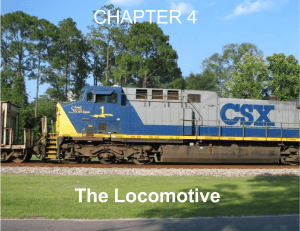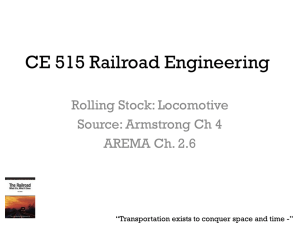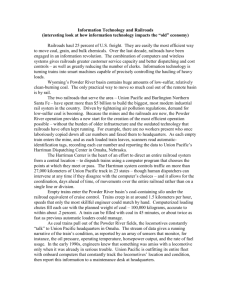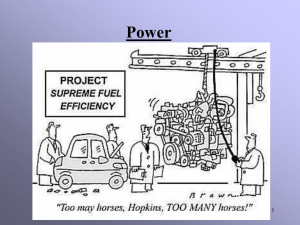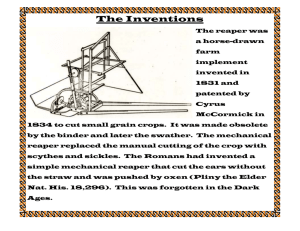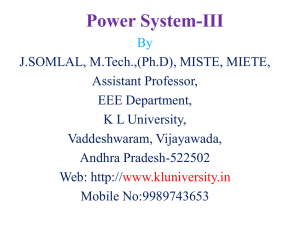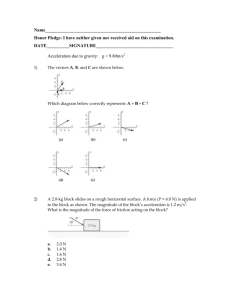5 - Indian Railways Institute of Mechanical and Electrical Engineering
advertisement
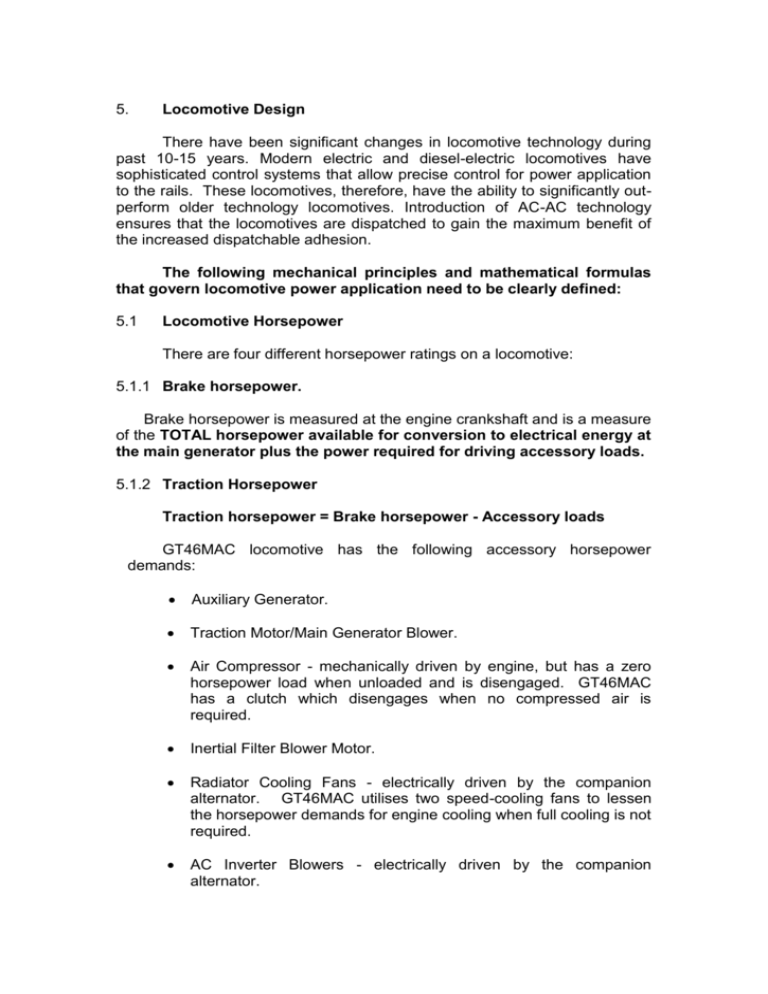
5.
Locomotive Design
There have been significant changes in locomotive technology during
past 10-15 years. Modern electric and diesel-electric locomotives have
sophisticated control systems that allow precise control for power application
to the rails. These locomotives, therefore, have the ability to significantly outperform older technology locomotives. Introduction of AC-AC technology
ensures that the locomotives are dispatched to gain the maximum benefit of
the increased dispatchable adhesion.
The following mechanical principles and mathematical formulas
that govern locomotive power application need to be clearly defined:
5.1
Locomotive Horsepower
There are four different horsepower ratings on a locomotive:
5.1.1 Brake horsepower.
Brake horsepower is measured at the engine crankshaft and is a measure
of the TOTAL horsepower available for conversion to electrical energy at
the main generator plus the power required for driving accessory loads.
5.1.2 Traction Horsepower
Traction horsepower = Brake horsepower - Accessory loads
GT46MAC locomotive has the following accessory horsepower
demands:
Auxiliary Generator.
Traction Motor/Main Generator Blower.
Air Compressor - mechanically driven by engine, but has a zero
horsepower load when unloaded and is disengaged. GT46MAC
has a clutch which disengages when no compressed air is
required.
Inertial Filter Blower Motor.
Radiator Cooling Fans - electrically driven by the companion
alternator. GT46MAC utilises two speed-cooling fans to lessen
the horsepower demands for engine cooling when full cooling is not
required.
AC Inverter Blowers - electrically driven by the companion
alternator.
Traction HP rating is the most commonly used rating when quoting
locomotive horsepower. When railroads dispatch loads on hp/ton basis,
they in almost all cases use traction hp for calculations.
5.1.2
Net Traction Horsepower
Net Traction Horsepower = Traction Horsepower x Generator Efficiency
In case of GT46MAC locomotive, 0.94 is the efficiency of the main generator.
5.1.3
Rail Horsepower
Rail horsepower, the power delivered by the locomotive wheels at the rails,
can be expressed by Rail Horsepower = Traction Horsepower x
Transmission Efficiency
Transmission efficiency is through:
Main Generator
Switch Gear
Cables
Traction Motors
Traction Motor Axle Gears.
Inverters
5.1.4 Draw Bar Horsepower
The power developed at the draw bar called Draw Bar Horsepower and is the
actual horsepower used to pull a trailing load. It is the engine to generator
horsepower minus electrical transmission losses minus horsepower
necessary to move the locomotive only.
Drawbar Horsepower =
{(Engine to Generator H.P. x Transmission Efficiency) resistance x kmph)}
(Loco weight x locomotive
270 kg km per hour
Due to the fact that the formula includes "locomotive resistance" and kmph, it
is necessary to specify the grade and curve condition as well as the speed of
movement to obtain draw bar hp value. The resistance for each one percent
of grade requires an additional 9.2 kg/t. Each degree of curvature requires
and additional about 0.37 kg/t. The influence of Rolling Resistance on DB
horse power will be explained later. It should be clear that the Draw bar
horsepower decreases with increased speed.
5.1.5
Horsepower Required to Pull a given Train Load
The calculations to find the Drawbar horsepower to pull a given train up a
specified grade and curvature can also be made.
Drawbar HP required =
Resistance X Wt. of Freight Car X No. of Freight Cars X kmph
270
Draw bar horsepower requirements will increase with increased speed.
5.2
Resistance
5.2.1 Rolling Resistance
The rolling resistance of a train can be determined by formula is
generally is taken from tables and curves based on formula. The most widely
used of such formulae is the "Davis Formula". Rolling resistance is
generally expressed in kg/t and is summation of Flange Resistance,
Journal Resistance and Air Resistance.
Other things being equal, total Rolling Resistance increases as speeds
increase.
5.2.2 Grade Resistance
Grade resistance, expressed in kg/t , is independent of and unrelated
to train speed. It is due to the force of gravity. It is always equal to 10
kg/tonne for each percent of grade as illustrated in the calculations below.
1 m rise
1% Grade =
100 m distance
when
Weight, W = 1 tonne = 1000 Kg
RG = 1/100 x 1000 Kg = 10 Kg
Grade resistance = 10 Kg per 1 % of grade.
Rise in elevation x 100 x RG (10
kg/t)
Total Grade Resistance =
Distance travelled
.
5.2.3 Curve Resistance
A one degree curve is a curve whose central angle extends to a chord
of 30.48 m (100 feet). A 30.48 m (100 feet ) chord is 1/360 of a complete
circle, the radius of a 1' curve is 1746.5 m (5730 feet). Curve resistance is
expressed in kg / t / degree.
Degree of curvature = 5730 / Radius in feet or 1746 / Radius in m
5.3 Tractive Effort
Tractive effort is defined as the turning force produced at the rails by
the driving wheels. Tractive Effort can be expressed mathematically as
follows for an AC locomotive.
Tractive Effort = Traction Horsepower x 315 mile-Ibs/hr / Speed in miles per
hour
or
Traction Horsepower x 230 km-kg/hr / Speed in km per hour
a.
Tractive effort depends on five major factors:
I. Horsepower of the diesel engine.
II. Ability of the main generator.
III. Ability of the traction motors.
IV. Gear ratio.
V. Adhesion
Weight on driving wheels.
Rail condition.
Wheel Slip Control System.
Inverter System.
b.
The effect of the above factors on tractive effort is explained
below:
i) Horsepower of the Engine
HP of the diesel engine primarily determines the possible TE a
locomotive can develop at the rims of the driving wheels. T.E
calculations use the Traction HP for calculation purposes.
With an increase in the horsepower of the engine, either T.E. of
the locomotive will increase for the same speed or speed will be
increase with the same T.E.
ii) Ability of the Main Generator
The main generator is the first step in the transmission of engine
horsepower to the wheels.
The main generator converts the
mechanical power into electrical energy, referred to as kW.
This
electrical energy is then used by the traction motors to turn the
locomotive wheels. kW are measured by the following formulas :
Main Generator Voltage x Main Generator
Current
Main Generator Kilowatts =
1000 W per kilowatt
Tractive Horsepower = Main Generator Kilowatt /0.746 HP per
kilowatt
The generator can produce any combination of amperage and voltage
within the rated power range of the locomotive.
iii) Ability of the Traction Motors
Traction motors transform the electrical energy of the main
generator into mechanical force to turn the locomotive wheels. At low
speeds, the traction motors must be capable of operating at their
thermal limit. Maximum locomotive speed is limited by the safe
rotational speed of the armature. In a DC motor, the armature
windings limit the maximum speed of the armature to approximately
2400 RPM. In an AC motor for the GT46MAC, the induction rotor
allows the operating RPM to increase to 3600 RPM.
The ratings of the traction motors also affect the "Minimum
Continuous Speed" of a DC locomotive, as well as the tractive
horsepower available for transmission to the motors. With an AC
locomotive, however,
"Minimum Continuous Speed" is not a
consideration. With AC traction motors, the locomotive can be put to
full throttle at standstill without any damage to the motors.
iv) Effect of Gear Ratio
At full load, a given power output will produce a corresponding
rotor speed regardless of gear ratio. The effect of changing gear ratio
is to change the train speed at which full load can be applied
continuously without thermal damage to the motors.
Therefore:
1. Increasing the gear ratio reduces the minimum speed (hence
increases tonnage) at which a given locomotive can operate
without heat damage to the motors.
2. Reducing the gear ratio, the maximum speed at which a given
locomotive can operate without mechanical damage to the motors.
v) Adhesion
Adhesion can be defined by the following locomotive formula:
% Adhesion = Tractive Effort (kg) X 100/ Locomotive Weight
There are three classes of adhesion:
Required (Train Weight and Grade dependent)
Available (Operation under a given set of rail conditions)
Developed (Locomotive capability through enhancements-wheel
slip control)
The adhesion rating of a locomotives depends upon confidence
level. This means that at a confidence level of 98%, the user can
count on the locomotive developing the given adhesion factor 98% of
the time. This is also termed as "All Weather Adhesion".
There are cases where trains can be dispatched with a lower
confidence level and a higher adhesion requirement. For example,
trains may be dispatched during the summer months at a lower
confidence level i.e. the user is counting on higher adhesions because
of good weather conditions. Under inclement weather conditions, the
locomotives can be dispatched at a higher confidence level of making
a successful trip as the rail conditions deteriorate. There is a large gain
in dispatchable adhesion as the confidence level drops to say 80 %.
This means that if one counts on the locomotive to produce 43%
adhesion, it will probably make the run successfully only 80% of the
time without help.
Weight on Driving wheels
The weight on the driving wheels is that portion of the entire
weight supported by the wheels driven by traction motors. The weight
on driving wheels is in an important factor in the locomotive's
"adhesion". Adhesion is the grip produced by friction between the steel
wheels and steel rails. Adhesion is required to keep the wheels from
slipping. In the modern locomotives which allow "wheel creep"
(controlled wheel slip), however, the maximum tractive effort can be
much higher due to the precise control of the wheel creep systems.
Rail Conditions
With a given weight on rails, adhesion depends on rail
conditions. Dampness, water, leaves, rust, ice, frost, and oil cause
rails to be slippery. With GT46MAC locomotive, the adhesion may
TEMPORARILY reach as much as 45% (with ideal rail conditions).
Practical year round adhesion factor may be as low as 33 %.
Wheel Slip Control System
The wheel slip control system used on a locomotive can have a
dramatic effect on the adhesion level achieved. Until the introduction
of the "Super Series" wheel slip control system, all wheel slip control
systems were "corrective" type systems. In other words, they operated
under the principle that all wheel slip is bad and would reduce power to
traction motors to control the slip.
The introduction of "Super Series" improved dispatchable
adhesion. The "Super Series" wheel creep control system allows the
wheels to exceed ground speed by a certain percentage, depending on
rail conditions, to improve adhesion. Super Series is activated
automatically through the control system.
The introduction of AC technology also improves the wheel
creep control system due to its rapid response. In a DC locomotive,
power is modulated by varying the DC field current of the main
generator. There is an inherent lag time as the main generator's
magnetic field requires time to collapse. With the AC locomotive, the
wheel creep corrections are far more rapid as the devices that control
the power output to the AC traction motors (called Gate Turn Off
Thrystors, or simply GT0s) can have their switching sequence changed
almost instantaneously. Power corrections are much more rapid and
smoother with the AC traction equipped locomotive.
Inverter System
GT46MAC locomotive utilizes a system called "truck control",
where one inverter controls all of the axles within a truck unlike GE
which uses single axle inverter system i.e. one inverter per axle.
While "truck control" system has less number of physical
components to maintain, this has the disadvantage of the power
reduction in the event of an inverter failure.
5.4
Dynamic braking effort
Dynamic braking effort may be considered as negative tractive effort. It is
useful for controlling train speed. Dynamic Brakes are normally not used to
stop a train but are used to assist deceleration.
Dynamic Brakes are the preferred tool to control train speed on, many
railroads for the following reasons:
i)
It saves considerable brake shoe wear, the subsequent reduction in
air brake use minimizes the chance of stuck brakes on the train.
ii)
It eliminates the fuel inefficient practice of 'Stretch braking' a train
with air brakes.
5.5
Brake Effort
Braking effort for a train can be calculated by the Following formula:
Brake Effort = (-GR r+ CR + CarR) x (Trailing load in tonne + Locomotive Wt.
in tonne)
where
5.6
GR
= Grade resistance
CR
= Curve resistance
CarR
= Car resistance
Comparison Between Four Axle & Six Axle Locomotive
Six axle locomotive has 50% more Traction Motors than a four axle
locomotive resulting in:
Six axle locomotive has about 50% more tractive effort than a four
axle locomotive.
Six axle locomotive weighs about
locomotive.
Six axle locomotive's minimum continuous speed is approximately
40% more than a four axle locomotives with equal horsepower.
50% more than a four axle
With equal trailing tonnage, six axle locomotive's running time on a given
run over the railroad is slightly longer than the four axle locomotive. This is
because of the increased rolling resistance with the additional two motors /
axles.
As a general rule, if the locomotive's primary mission is to haul trains at
high speeds (intermodal use), four axle locomotive is better suited. If the
locomotive's primary responsibility is heavy service over terrain with grades
and curves, six axle locomotive is better suited.
